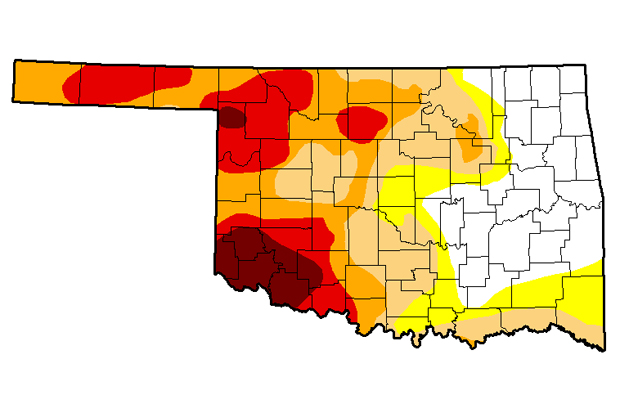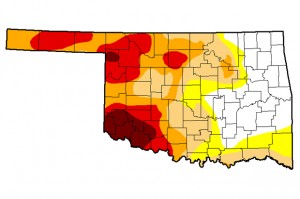
The December 30, 2014 update of the U.S. Drought Monitor for Oklahoma.
U.S. Drought Monitor


The December 30, 2014 update of the U.S. Drought Monitor for Oklahoma.
U.S. Drought Monitor

U.S. Drought Monitor
The December 30, 2014 update of the U.S. Drought Monitor for Oklahoma.
The drought in southwest Oklahoma has lingered for more than four years now, and it will take more than a wet end to 2014 to stop it — a lot more.
Despite receiving above average December precipitation, the City of Duncan will ban all outdoor watering beginning next week. That’s because water levels in Waurika Lake, Duncan’s only current drinking water source, continue to drop.
From The Duncan Banner‘s Rachel Snyder:
Outside watering includes watering of lawns or plants, as well as washing cars, hosing down streets and sidewalks or filling of pools.
City Manager Jim Frieda said the most recent data indicates Waurika Lake’s municipal water supply is at 29.9 percent capacity, which prompted Stage 5 restrictions effective Wednesday. Waurkia Lake is currently the city’s sole source of drinking water.
When StateImpact visited Duncan in September, Waurika Lake was 32 percent full. At the time, Public Works Director Scott Vaughn said the lake was “about a year’s worth of rainfall behind,” and while the city owns rights to water in four other area lakes, they, too, have been severely affected by drought.
Duncan shares the water in Waurika Lake with other communities, including Lawton, which is looking underground to meet its future water needs in the face of the drought.
“In the past the city of Lawton had groundwater, but for the last 40 years or so, Lawton has relied on surface water,” the City of Lawton’s Afsaneh Jabbar told StateImpact in September. “Now we’re looking at groundwater to see if that’s an option for us.”
The Waurika Lake Conservancy District estimates the lake could be too low to use as a water source by the middle of 2016 if the drought continues.